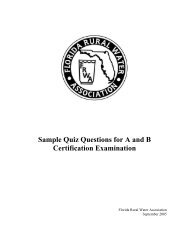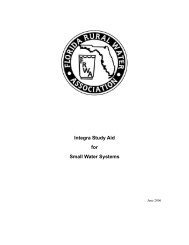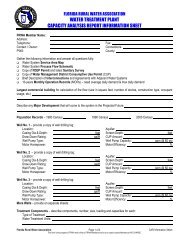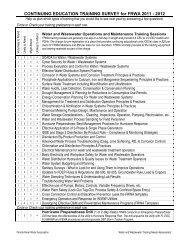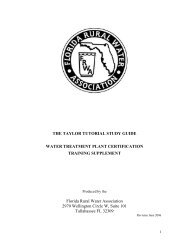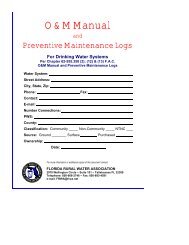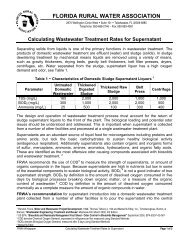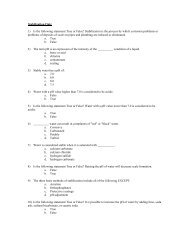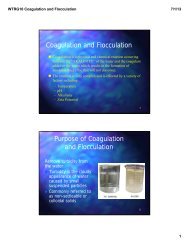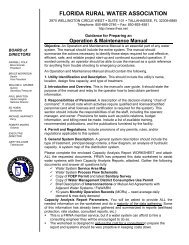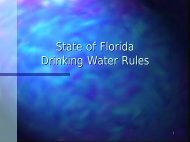Demineralization Quiz 1.When hard water is softened by the ion ...
Demineralization Quiz 1.When hard water is softened by the ion ...
Demineralization Quiz 1.When hard water is softened by the ion ...
- No tags were found...
You also want an ePaper? Increase the reach of your titles
YUMPU automatically turns print PDFs into web optimized ePapers that Google loves.
<strong>Demineralizat<strong>ion</strong></strong> <strong>Quiz</strong><strong>1.When</strong> <strong>hard</strong> <strong>water</strong> <strong>is</strong> <strong>softened</strong> <strong>by</strong> <strong>the</strong> <strong>ion</strong>-exchange process, which substances are normally retained <strong>by</strong> <strong>the</strong>exchange media?a. Sodium and potassiumb. Sulfates and nitratesc. Calcium and magnesiumd. Chlorides and sulfides2. Which process <strong>is</strong> not applicable for removal of carbon dioxide?a. Aerat<strong>ion</strong>b. Lime softeningc. Ion exchange softeningd. Addit<strong>ion</strong> of caustic soda.3. What practice <strong>is</strong> used in a <strong>ion</strong>-exchange softening plant to obtain a 5-grain <strong>hard</strong>ness in <strong>the</strong> fin<strong>is</strong>hed<strong>water</strong>?a. Addit<strong>ion</strong> of sodium hydroxideb. Addit<strong>ion</strong> of d<strong>is</strong>solved oxygenc. Addit<strong>ion</strong> of <strong>by</strong>passed <strong>water</strong>d. Addit<strong>ion</strong> of sodium chloride4. Hydrolys<strong>is</strong> of a membrane results in an increasing of mineral reject<strong>ion</strong> capability.1. True2. False5. Limitat<strong>ion</strong>s of <strong>the</strong> <strong>ion</strong> exchange softening process includea. Causes format<strong>ion</strong> of soap curdsb. Deposit<strong>ion</strong> of scale in boilersc. Increase in sodium content of <strong>softened</strong> <strong>water</strong>d. Increased use of soape. Ultimate d<strong>is</strong>posal of spent brine6. The reserve osmos<strong>is</strong> elements should be cleaned when <strong>the</strong> operator observesa. Higher differential pressuresb. Higher operating pressuresc. Higher suspended solids in product <strong>water</strong>d. Lower product <strong>water</strong> flow ratee. Lower salt reject<strong>ion</strong>7. Which of <strong>the</strong> following materials should be removed from <strong>the</strong> feed<strong>water</strong> to an electrodialys<strong>is</strong> unit?a. Calciumb. Carbon dioxidec. Hydrogen sulfided. Irone. Magnesium8. Wastes from demineralizat<strong>ion</strong> process are typically d<strong>is</strong>posed of <strong>by</strong>:a. D<strong>is</strong>charge to a sanitary sewer with proper permitb. D<strong>is</strong>charging to a river or surface body to achieve adequate dilut<strong>ion</strong>c. Hauling dried sludge to landfilld. Recycling to headworkse. Spreading on agricultural soils for pH adjustment
9. Which <strong>is</strong> not one of <strong>the</strong> four stages of <strong>the</strong> <strong>ion</strong> exchange process?a. Backwashb Servicec. Brine or Regenerat<strong>ion</strong>d. Recyclee. Rinse10. In <strong>the</strong> <strong>ion</strong> exchange process a membrane <strong>is</strong> used to remove Calcium <strong>ion</strong>s.1. True2. False11. In Reverse Osmos<strong>is</strong> increasing <strong>the</strong> flux rate will cause an increase in salt concentrat<strong>ion</strong>.1. True2. False12. Constituents affecting <strong>the</strong> RO include all but which of <strong>the</strong> following:a. pHb. Temperaturec. Suspended Solidsd. Microbrial Concentrat<strong>ion</strong>e. Conductivity15. Fouling in RO systems <strong>is</strong> typically caused <strong>by</strong>:a. Backwash Frequencyb Service on Membranesc. High Water Pressured. Bacteriae. Concentrat<strong>ion</strong> of Calcium in Rinse Water16. Polarizat<strong>ion</strong> in an RO system <strong>is</strong> caused <strong>by</strong>:a. Fouling caused <strong>by</strong> high <strong>hard</strong>nessb Fouling of <strong>the</strong> Anode or Cathodec. Brine or Regenerat<strong>ion</strong> concentrat<strong>ion</strong> that <strong>is</strong> too highd. Mineral Deposits along <strong>the</strong> edge of a membranee. Plugging of Membrane inner surfaces17. Reverse Osmos<strong>is</strong> Systems do not require pretreatment to remove colloidal material.1. True2. False18. RO systems are best operated with all units in series to gain maximum removal rates.1. True2. False19. Electrodialys<strong>is</strong> <strong>is</strong> a <strong>water</strong> treatment process that uses electricity instead of membranes to removeminerals.. 1. True3. False20. If a salty taste <strong>is</strong> noted in an RO process what <strong>is</strong> <strong>the</strong> most probable cause:a. Polarizat<strong>ion</strong> <strong>is</strong> occurringb Service rate us too lowc. Brine or Regenerat<strong>ion</strong> Rate should be increasedd. Recycle Stream <strong>is</strong> too highe. Rinse Rate should be increased



